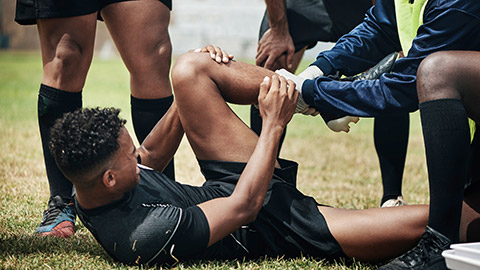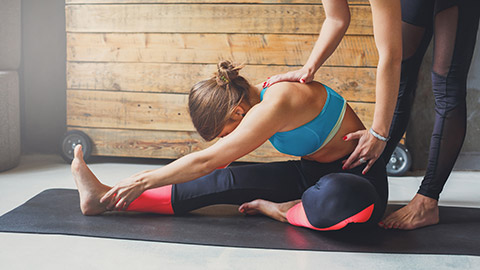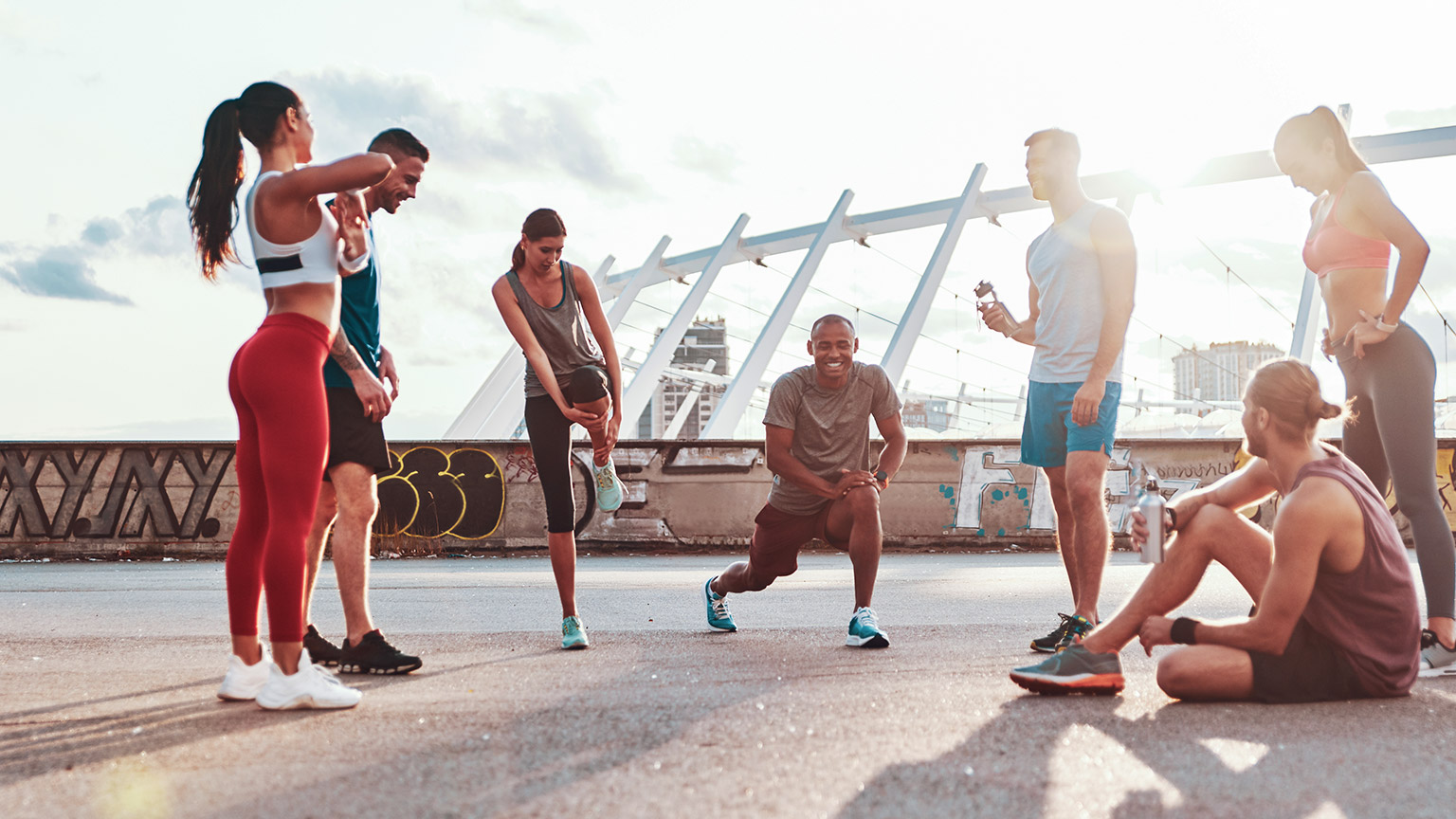In general, sports and exercise programmes or prescriptions are built using 3 blocks or stages:
- Warm-up
- Main activity
- Cool-down
A good programme starts with an effective warm-up and finishes with a cool-down. We all know that warm-ups and cool-downs are important, but likely do not implement them as often as we should! In this topic, we will cover the benefits of warm-ups and cool-downs, and look at how to structure them.
In this topic, you will learn about:
- Injury and injury prevention
- Warm-ups
- Cool-downs
- Types of procedures
One of the main reasons for doing warm-ups and stretches is to prevent injuries.
Common injuries

During sporting events and exercises, injuries involving the joints, ligaments, and tendons may occur. The knee and ankle joints, as well as the surrounding ligaments and tendons are common sites for tears and sprains.
In netball, ankle sprains are the most common injuries to occur on the court. In football, knee sprains occur regularly, particularly tears in the anterior cruciate and medial collateral ligaments. These types of injuries are known as soft tissue injuries as they affect different types of soft tissue in the body, such as ligaments, tendons, and muscles. Think back to anatomy and physiology and answer these questions.
Acute ligament injuries can occur when ligaments are suddenly over-stretched, which results in the ligament being weakened or torn. It is usually caused by an abnormal movement of the foot and ankle, which puts a tremendous stretch on the ligaments ending in the tearing or weakening of the ligaments surrounding the affected joint.
Avoiding training injury
Key things to avoid sustaining an injury because of resistance training:
- Consult a doctor before beginning - this is especially important for people with health issues.
- Write programmes specifically for the individual client and their specific needs and circumstances.
- Start slowly and within the client's capabilities.
- Correct technique - check the exercises are being carried out correctly.
- Include warm-ups and cool-downs in the programme.
- Use equipment safety - if using equipment, ensure it is safe and used correctly.
- Rest the muscle group for at least 24 hours before training it again.
Why warm-up? Warm-ups prepare your body mentally and physically for the exercise that follows. It also allows you to connect with your client, build rapport, and check in with their emotional and physical state.
Warm-ups gradually ‘rev’ up the cardiovascular system to increase blood flow to muscles and raise the temperature of the body. Blood transports essential nutrients, and gases and removes metabolic wastes, as well as delivering heat to the skin and maintaining homeostasis.
An effective warm-up generally consists of 2 phases:
- General phase
- Specific phase
The general phase typically is 5 minutes of low-moderate intensity cardiovascular exercise and uses muscles that will be engaged during the main programme. E.g., a weight training exercise for the upper body may include 5 minutes on a rowing machine as a general warm-up.
The specific phase is made up of exercises that are similar (or specific) to the exercises that follow in the main programme. This primes the nervous system, exposing muscles, joints, and connective tissue to the range of motion coming up, but with a lighter load. E.g., if the main workout will include squats and deadlifts, some warm-up sets of these specific exercises but with lighter loads will prepare the body for the main workout (PT Direct, n.d.).
What happens to the body during warm-up?
An effective warm-up achieves a physiological response across multiple systems:
- Cardiovascular - blood flow redistributed from internal organs to working muscles. Heart rate, stroke value, and systolic blood pressure increase.
- Musculoskeletal - muscle temperature increases and muscle stiffness is reduced, improving the range of motion at joints.
- Respiratory - rate and volume of ventilation increases, gaseous exchange increases in lungs and body's tissues.
- Nervous - neural pathways primed for activity.
- Metabolic - change in hormonal levels.
Physical benefits
In addition to preventing injury, the benefits of warm-ups include increases in the:
- body temperature.
- muscle blood flow.
- sensitivity of nerve receptors.
- disassociation of oxygen from haemoglobin to myoglobin.
- speed of nerve impulse transmissions.
- flexibility and the body’s ability to move during exercise.
Warm-ups help protect against injury because cold muscles with low blood flow are more susceptible to injury or damage. Muscle elasticity is dependent on muscle blood flow.
Heat production
As the name suggests, warm-ups generate heat production in the body. The main causes of heat production include:
- friction through sliding filaments during muscular contraction.
- an increase in fuels being metabolised.
- dilation of intramuscular blood vessels through increased blood flow.
The following video will walk you through a field-based warm-up session for cross-fit athletes, including drills such as the high knee karaoke, over-the-hurdle drill, knee to chest, figure four, lunge, lunge with torso twists, and toe touches. The exercises start from a walking pace and progress up to the intensity required for the main exercise.
Psychological benefits
In addition to the physiological benefits, there are also psychological benefits associated with warming up:
- Enhance mental preparation and readiness
- Lower nerves and anxiety
- Promote optimal performance
- Prevent under or over-stimulation (choke factor)
- Consolidate routine
Watch
Mental fear can affect the brain and physical responses. Watch how the US Navy Seals prepare their mental skills and control fear. As you watch, consider how techniques to control fear can be applied to athletes.
The video identified arousal control as an important factor. Now, look at the following graph that plots performance against arousal levels. Note where the optimum level of arousal and performance intersect and where factors such as boredom and stress impact performance.
RAMP protocol
The RAMP protocol includes 3 – 4 stages and is a great concept to base your warm-up planning around. RAMP stands for:
- Raise
- Activate
- Mobilise
- Potentiate
Watch the video for an explanation of RAMP and complete the activity that follows.
As with the physiology of a warm-up (gradually introducing the body to exercise or physical activity), the same physiology applies to the cool-down at the end of a programme. It is equally as important to expose the body to a gradual reduction in exercise intensity.

Your body has increased its output to sustain the exercise regime with blood pumping around the body more rapidly, supported by the heart to allow functions such as breathing and muscular contraction to occur at an increased rate, not to mention the metabolic activity within the cells. These processes should be allowed to decline gradually to avoid risks such as blood pooling in the legs, which could cause fainting or vascular damage in the legs, and cardiac issues.
Allowing these processes to gradually cool down is recommended, especially after strenuous intense exercise before the exercise stops completely. In other words, they restore physiologic systems close to their baseline and are an important stage in recovery (lactate removal via oxidation).
Cool-down also provides you with a relaxed setting to talk with your client. How did they find the session? What is happening outside training sessions which may impact their training, commitment, or wellbeing? Is the current programme too hard, easy, or just right? In this next video, Davy discusses why stretches are a great opportunity for client communication.
Cool down structure
Static stretching should be included to restore the full range of motion. Follow these points to ensure the cool-down is effective.
- Perform 5-10 minutes of light to moderate aerobic activity (30-40% VO2 max).
- Incorporate dynamic mobility stretches.
- Perform static stretches covering all muscles used in the session.
- Hold all static stretches for a minimum of 30 seconds and perform 2-3 sets.
Stretching cold muscles does not increase flexibility and may also lead to or result in injury (therefore, defeating the purpose of stretching). Physiologically it is safer and more effective to stretch warm muscles. This is why stretching is a component of a warm-up and cool-down, while the body is at the optimal state for effective stretching.
Static stretches include calves, glutes, quads, hamstrings, abdominals, pectorals, and lats.
Benefits
Stretching, whilst incredibly effective after any type of exercise, is particularly effective and important after strength training. Strength training involves putting tension into the muscles and across the joints and their structures, therefore stretching out a suitable level of tension is required to ensure optimal functional recovery (this does not mean there will not be muscle soreness from training!)
We also need to stretch to:
- protect mobility and independence.
- keep muscles flexible, strong, and healthy.
- maintain motion in the joints.
- increase blood flow and reduce stiffness.
- prevent injuries to the muscles which can lead to joint injuries.
Watch
Watch the following video for more information on cool-down. The video includes a mix of cardio and stretching and requires no equipment. You will learn that not all exercises are suitable for everyone and what you need to consider before you start a client on a cool-down. E.g., consider the flexibility, strength, and overall health of the client to decide if the exercises are suitable or not.
